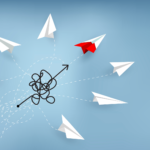WHAT IS IT ALL ABOUT
In the galaxy of business, transformation and innovation are twin stars, each powerful in its own right, yet truly stellar when aligned. The Synchronous Orbit Framework is engineered to help organizations navigate the gravitational pull of these forces, ensuring they move in concert to illuminate new paths of growth and opportunity.
The Synchronous Orbit Framework: An Overview This framework orbits around five strategic phases: Ideation Integration, Cultural Cohesion, Strategic Synchronization, Execution Ecosystem, and Evolutionary Feedback. It’s a cyclical process, designed to keep transformation and innovation in a perpetual state of synergy.
1. Ideation Integration: Seeding the Future In the Ideation Integration phase, the seeds of the future are planted. It’s about ideating with intent—defining the problems to be solved and the futures to be realized through both transformative and innovative lenses.
For Example: When Salesforce ventured into the cloud CRM space, it integrated the idea of transforming sales processes with the innovative concept of cloud computing, changing not just a product but an entire industry’s approach to customer relationship management.
2. Cultural Cohesion: Weaving a Tapestry of Change Cultural Cohesion weaves a tapestry of change, blending the threads of transformation (often structural and strategic) with those of innovation (typically creative and disruptive). It’s the deliberate fusion of cultural elements that support both change and creativity.
For Example: 3M is known for its culture that intertwines transformation—like its shift to sustainability—with a storied history of innovation, producing a steady stream of new products while reshaping its market approach.
3. Strategic Synchronization: Aligning Orbits Strategic Synchronization involves aligning the orbits of transformation and innovation, ensuring that they do not clash but complement. It’s about crafting strategies where the pursuit of innovation strengthens transformation, and transformative actions create a fertile ground for innovation.
For Example: When IBM transformed from a hardware company to a solutions and services business, it strategically synchronized this shift with investments in AI and blockchain, setting the stage for innovations that supported its new direction.
4. Execution Ecosystem: Creating a Unified Force Execution Ecosystem is the practical manifestation of the Synchronous Orbit Framework. Here, cross-pollination is key—cross-functional teams work in unison to implement innovative projects within the wider transformative agenda.
For Example: The collaboration between auto manufacturers and tech companies to develop autonomous vehicles is an execution ecosystem. Car companies are transforming manufacturing processes while tech companies innovate on software, creating a unified force to reshape the future of transportation.
5. Evolutionary Feedback: Learning to Pivot and Propel Evolutionary Feedback is the mechanism that ensures the framework adapts and evolves. This phase is about learning from each cycle, using data and insights to pivot strategies, propel future innovation, and inform ongoing transformation efforts.
For Example: Netflix’s continuous evolution from a DVD rental service to streaming, and then to content creation, is an example of evolutionary feedback in action. They’ve mastered the art of using customer data and market trends to guide both their transformative journey and innovative content strategies.
The Synchronous Orbit Framework is not simply a set of steps; it’s a living strategy that enables organizations to harness the dual powers of transformation and innovation. Through this framework, businesses are equipped to create a reality where change is not just managed but anticipated and where innovation is not sporadic but systematic. Companies like Apple, which consistently aligns transformative strategies—like breaking into new markets—with innovation—in creating category-defining products—demonstrate the effectiveness of this approach. This dual focus ensures that as one process orbits, the other gravitates, maintaining a synchronous dance that leads to sustained industry leadership and resilience. The result is a business cosmos where transformation and innovation, like twin stars, shine brightly and steadfastly into the future.
A 6 STEPS APPROACH TO DEPLY IT
Deploying the Synchronous Orbit Framework to effectively synchronize transformation and innovation in an organization requires a structured, strategic approach. Here is a six-step method to ensure that these two vital forces enhance and support each other throughout the deployment process:
Step 1: Establish a Unified Vision
- Objective: Align leadership on a shared vision that integrates both transformation and innovation goals.
- Action: Conduct strategic planning sessions with key stakeholders to define what transformation and innovation mean for the organization, ensuring clarity and commitment from the top down. This vision should articulate how innovation is not just a support function to transformation but a strategic partner.
Step 2: Assess and Align Organizational Culture
- Objective: Ensure the organization’s culture is prepared to embrace both transformation and innovation.
- Action: Perform a cultural assessment to determine current values, behaviors, and norms. Develop initiatives to foster a culture that encourages experimentation, tolerates failures as learning opportunities, and promotes agile decision-making. This might include training programs, internal communications, and revising reward systems to support desired behaviors.
Step 3: Design Integrated Strategic Plans
- Objective: Create detailed plans that outline how transformation and innovation will be implemented and measured.
- Action: Develop roadmaps that identify key initiatives, projects, and milestones. Ensure that transformation projects are designed to include innovative practices, and that innovation projects consider transformative goals. Use workshops and collaborative tools to involve a wide range of personnel in this planning process to gain diverse insights and buy-in.
Step 4: Establish Cross-Functional Teams
- Objective: Build teams that can work across the boundaries of traditional departments to implement the integrated plans.
- Action: Formulate teams comprising members from different functional areas, including R&D, IT, marketing, operations, and human resources. These teams are tasked with executing specific projects that embody both transformative and innovative elements. Provide them with the necessary tools and authority to act decisively and creatively.
Step 5: Implement with Continuous Communication
- Objective: Execute the strategic plans while maintaining open lines of communication across the organization.
- Action: Roll out the initiatives according to the roadmap, accompanied by regular updates to all stakeholders. Utilize multiple communication platforms to ensure transparency and to keep the workforce informed and engaged. Celebrate milestones to generate excitement and sustain momentum.
Step 6: Monitor, Learn, and Adapt
- Objective: Establish feedback loops to monitor progress and adapt strategies as necessary.
- Action: Use performance metrics and regular feedback mechanisms to track the effectiveness of transformation and innovation efforts. Conduct review meetings at regular intervals to assess what’s working and what isn’t. Adapt plans based on feedback and changing market conditions to ensure the organization remains responsive and agile.
Conclusion The six-step approach to deploying the Synchronous Orbit Framework enables organizations to effectively leverage the twin powers of transformation and innovation. By following these steps, businesses can ensure that these efforts are not only aligned but also mutually reinforcing, leading to sustainable growth and continued relevance in their markets. This systematic approach helps in creating a dynamic organization where change and creativity become the core drivers of success.












About The Author
Janus Andersen
Advice on Strategy | Innovation | Transformation | Leadership Helping growth strategies and M&A transactions for 20 years